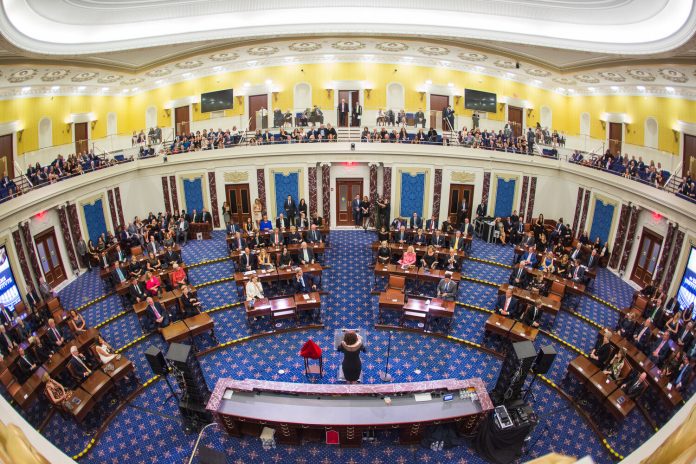
With all signs pointing to an incredibly close race for the presidency, Republican candidate Donald Trump defeated Democratic frontrunner Kamala Harris in the 2024 presidential election in dominant fashion. The election was predicted to have seven key “swing states” including Michigan, Wisconsin, Arizona, Nevada, Georgia, North Carolina and Pennsylvania, where the victories there would decide the winner. Instead of the predicted close outcome, Donald Trump has either won or is projected to win all seven swing states.
In the 2022 midterms, it was predicted by many Republicans that there would be a “Red Wave,” where Republicans would reclaim the Senate. Typically, the president’s party loses seats during midterm elections, and the Red Wave movement believed this would occur again.
It didn’t.
The Democrats held a majority in the Senate of 51-49 two years prior, and the Republicans vastly underperformed in the House, taking a slim majority. The Red Wave of 2022 failed. 2024, however, is a different story.
The Republican Party has managed to reclaim a majority in the Senate, with 53 seats and still counting. Republicans are also optimistic that they can win the House of Representatives and build a strong lead there. This would give all three branches of government a Republican majority, meaning a path of low resistance for Trump to execute his agenda.
The lesser-studied legislative races are just as important as the presidency, as many races factored into this victory. Here are some of the major flips for the Republicans, along with the ones that got away.
Ohio - Bernie Moreno defeats Sherrod Brown
In what was shaping to be the closest Senate race in this election cycle, Republican political outsider Bernie Moreno has defeated Incumbent Democrat Sherrod Brown. Despite Ohio becoming increasingly more conservative, Brown has been a senator for three terms, where he first defeated current Ohio governor Mike DeWine. Brown’s support comes from his platform as a populist Democrat, centering the blue-collar workers and unions that are prevalent in Ohio. Meanwhile, Moreno is a Colombian immigrant and an owner of multiple car dealerships. He has no prior political experience.
Moreno defeated Brown by four points, a wider margin than most anticipated, as many believed he would have an uphill battle against Brown and his longtime experience. However, Moreno was able to appeal to the increasingly red state and win the election by a wider margin than most expected. Moreno’s win means he will serve in the Ohio senate next to a new appointee in January, as Senator JD Vance will resign the rest of his term once he is sworn in as Vice President.
Texas - Ted Cruz defeats Colin Allred
A much less intense race occurred in the southwest, with Ted Cruz winning his third term in the Texas Senate over former representative Colin Allred. Cruz’s political career goes back much further than the Senate, giving him an extensive career. In 2018, Cruz was in a surprisingly tight race with former Democratic representative Beto O’Rourke, who garnered the most votes ever for a Democrat in Texas, losing by less than three points.
Allred, a former representative and professional football player, was Cruz’s challenger this time around, and with some controversy about Cruz’s handling of natural disaster earlier in his term. Many thought Allred would be Cruz’s biggest challenge yet. Instead, Cruz defeated Allred by almost one million votes, showing the strength of the Republican voting base in Texas. While Allred was never projected to beat Cruz, a trend toward a bluer Texas was only a mirage.
Wins for Democrats - Elissa Slotkin defeats Mike Rogers, Tammy Baldwin defeats Eric Hovde
Two other swing states, Wisconsin and Michigan, had major senate battles this cycle, both of which were incredibly close but leaning Democrat. Despite both states going to Trump for the presidency, the Senate did not follow, going blue.
Michigan’s race between Slotkin and Rogers had many interesting factors at play. Since 1994, Michigan Democrats have held both seats in the Senate and never lost them, despite voting Republican multiple times in the presidency. Incumbent Democrat Debbie Stabenow chose to retire, leaving Slotkin the opportunity to run and replace her. Slotkin and Rogers both have experience in the House of Representatives and in security, with the CIA and FBI respectively. Despite Michigan voting for Trump and the Red Wave trending nationwide, Slotkin was named the victor, and the blue streak for Michigan’s Senate remains intact.
Wisconsin’s race, in many ways, mirrors Michigan. Both states are part of the “Blue Wall” in the Midwest, where Democrat support over the years has been largely consistent. While the margin of victory was greater in Wisconsin than Michigan, a big help to Democrat Tammy Baldwin’s win was third-party candidate Thomas Leager, a conservative who Republican Eric Hovde accused of being paid by Democrats to run and take votes away from him. Whether Leager is a factor or not, Baldwin wins in a close one.
